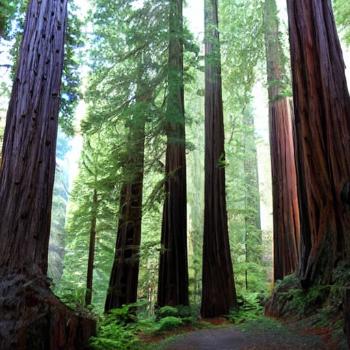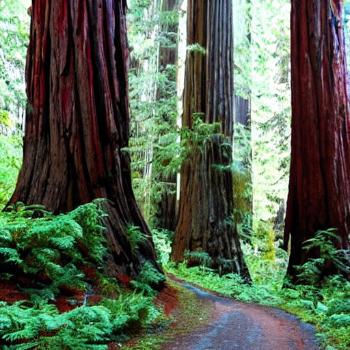Why are Redwood Trees So Big? According to research, redwood trees are so big because they have acquired a special quality that helps them grow into enormous trees. This trait is similar to their ability to absorb water from fog. The main cause of redwoods’ amazing growth in size and height is their outstanding capacity for survival, particularly their capacity to avoid death.
Due to a combination of circumstances, including their long evolutionary history and their innate ability to thrive in the temperate temperature and fog-filled environment they call home, these trees have a towering size. Their habitat’s environmental factors, which include regular exposure to damp and fog, provide a favorable setting for their development.
In addition, a number of other variables contribute to the amazing development and prolonged lifespans of redwood trees. One outstanding characteristic of their continued existence is their extraordinary resilience to pests, diseases, and fire, which commonly endanger other species. The characteristics they have accumulated through time are what explain their resilience.
The enormous snowfall in California also contributes significantly to the survival of sequoia trees because it penetrates the ground and continually delivers moisture to their roots. Additionally, due to these trees’ remarkable height, the highest needles are exposed to higher amounts of dry heat than the lower branches, which are sheltered by the thick canopy.
Giant sequoias’ enormous size is mostly the consequence of its long lives and fast development. Large volumes of water are necessary for their survival, which they mostly meet via a variety of techniques.
Redwoods’ distinctive characteristics and the environment they live in are directly related to the topic of why they grow to such enormous heights. These trees are not only amazing works of nature, but they also have a big impact on the environment because of their size, longevity, and decay-resistant wood, which enable them to absorb and hold a lot of carbon from the atmosphere, reducing the effects of carbon emissions.
Why do giant redwoods only grow in California?
The giant redwoods, also known as coastal redwoods, are only found in California due to the specific conditions required for their growth. The moist and humid climate of the Northern California coast provides the necessary environment, with marine fog contributing moisture to the soil and reducing evaporation rates.

What is so special about redwood trees?
The special qualities of redwood trees include their impressive height, deep-rooted strength, natural resistance to various elements, and their ability to form interconnected groves.
Because of their long history and amazing adaption to the temperate and foggy environment they live in, redwood trees have a towering height. They may reach amazing heights because to this adaptability. Redwoods grow to vast heights, yet their shallow root systems only reach 6 to 12 feet below the surface of the earth. They did, however, extend their roots outward to cover a space up to 100 feet wide from the stem in order to offset this. They are resilient enough to withstand powerful winds and floods because to their integrated root network.
Due in part to their innate resilience to dangers like insects, fire, and decay, the majestic trees have survived the test of time. Their bark serves as armor, providing both chemical and physical defense. Their heartwood and bark are reddish-brown in color because to high tannin levels, giving them stronger defenses against a variety of threats. They are also more resistant to fire and fungus assaults due to the lack of resin or pitch.
In addition, redwood trees have a distinctive social structure by creating groves where their roots entangle. This connectivity enables the transfer of resources and nutrients among the trees as well as ensuring structural integrity. They benefit from this arrangement’s combined strength, which increases their lifetime and capacity for growth.
Additionally, these magnificent trees support the habitats in which they live. They provide tranquil habitats where aquatic species may take shelter by shading bodies of water and providing cooling shade. They provide organic stuff to the soil, enriching it, and promoting the development of other plants as they lose their leaves and branches.
The Natural Wonders Of Redwood Trees

Redwood trees, with their towering presence, captivate our imagination. These majestic giants possess unique characteristics that contribute to their impressive size. The formations of vast redwood forests create a wondrous spectacle of nature. But what makes these trees grow to such extraordinary heights?
The answer lies in the role of climate. Redwood trees thrive in regions where a combination of rainfall and fog is plentiful. This moist environment provides the necessary conditions for their growth. Additionally, the mild temperature and absence of extreme weather events further support their development.
Through adaptation, redwood trees have perfected their ability to absorb and store water, allowing them to reach incredible heights. Understanding the natural wonders of redwood trees and the factors that contribute to their growth unlocks the beauty and fascination surrounding these magnificent giants.
How old are redwood trees
With an average lifespan ranging between 500 and 700 years, the coast redwood tree is recognized as the sole extant species within the genus Sequoia, belonging to the cypress family Cupressaceae (formerly categorized as Taxodiaceae). Various common names are attributed to this tree, including coast redwood, coastal redwood, and California redwood. Being an evergreen and long-lived monoecious tree, it is capable of living for a span of 1,200 to 2,200 years or even more.
These trees may grow to extraordinary heights of more than 360 feet. They can live for more than 2,000 years, in fact. They are given the name “sequoia sempervirens,” which translates to “sequoia ever-living,” because of their very long lifespan. The main justification for this designation is the magnificence of their lengthy life.
Redwood tree roots intertwined
The tallest redwood trees, known as the coast redwoods, can reach heights exceeding 115 meters. These trees can grow to be over 300 feet high and more than 30 feet thick at their base. Some of the tallest redwoods measured in the early 21st century were even more than 370 feet in height.
According to a study from March 7, 2021, the interconnection of these roots provided an important function in addition to supporting the trees. The redwood trees showed an innate capacity to interweave their roots, producing a network that successfully promoted the transfer of nutrients and served as a structural support. This symbiotic link between redwoods was reaffirmed in a conversation dated February 10, 2023, which contrasted the weak roots and towering height of the enormous redwood trees in northern California, which may grow up to 350 feet above the earth.
The shallow root systems of the trees, which extended more than 100 feet from the base and intertwined with the nearby redwoods, were highlighted in the discussion of this phenomena. The most important finding was that the redwoods’ complicated root system interweaving, which allows them to support and maintain one another, was still relevant as of July 1, 2021.
Redwood tree height in meters
The tallest redwood trees, known as the coast redwoods, can reach heights exceeding 115 meters. These trees can grow to be over 300 feet high and more than 30 feet thick at their base. Some of the tallest redwoods measured in the early 21st century were even more than 370 feet in height.
The Ecological Significance Of Redwood Trees
Redwood trees, known for their enormous size, play a crucial role in ecological balance. These trees are biodiversity hotspots, supporting a wide variety of plant and animal species. Their immense size allows them to store and sequester large amounts of carbon dioxide, aiding in the fight against climate change.
Redwoods contribute to forest ecosystems by providing habitat for countless organisms and promoting healthy soil conditions. Additionally, their towering presence creates a unique microclimate within their surroundings, affecting temperature and moisture levels. This fosters the growth and survival of other plant species, enhancing overall ecological diversity.
The ecological significance of redwood trees cannot be overstated, as they serve as vital pillars of life and contribute to the delicate balance of our natural world.
Frequently Asked Questions On Why Are Redwood Trees So Big
Why Are Redwood Trees So Big?
Redwood trees, particularly the giant sequoias, grow to immense heights thanks to a combination of factors. These trees have evolved over millions of years to take advantage of ample sunlight and moisture. Their genetics also play a role, enabling them to grow tall and wide.
Additionally, the mild climate and lack of natural disasters in their habitats contribute to their impressive size.
How Long Do Redwood Trees Live?
Redwood trees are known for their incredible longevity. These trees can live for up to 2,000 years, making them some of the oldest living organisms on earth. Their longevity is attributed to their ability to adapt to their environment and resist disease and pests.
What Makes Redwood Trees Resistant To Fire?
Despite their enormous size, redwood trees have developed several adaptations to withstand wildfires. Their thick bark acts as a protective shield, insulating the tree from heat and flames. Additionally, redwoods have high water content, which makes them less flammable. The height of these trees also helps them avoid the heat and avoid catching fire easily.
How Do Redwood Trees Grow So Tall?
Redwood trees are able to reach such impressive heights due to various factors. One key factor is their ability to absorb and transport water and nutrients efficiently, thanks to their extensive root system. Their high photosynthetic capabilities, along with access to plentiful sunlight, enable them to produce ample energy for growth.
As a result, these trees can grow several feet per year.
Conclusion
The towering stature of redwood trees can be attributed to several factors. These giants of the forest have evolved to thrive in the unique ecosystem of california’s coastal regions, where a combination of favorable climate, rich soil, and fire-resistant bark has allowed them to grow to such astounding heights.
Their ability to absorb water through their roots and transport it efficiently to their massive trunks also contributes to their impressive size. Additionally, the longevity of redwoods, with some individuals surpassing two millennia, allows them to continue growing and accumulating mass over centuries.
The ecological significance of these ancient trees cannot be overstated, as they provide habitat for countless species, contribute to climate regulation, and capture substantial amounts of carbon dioxide. The awe-inspiring size and grandeur of redwood trees make them an invaluable part of our natural heritage, deserving of our admiration and protection.
With continued conservation efforts, we can ensure that these magnificent giants continue to thrive for generations to come.
Also Read :
